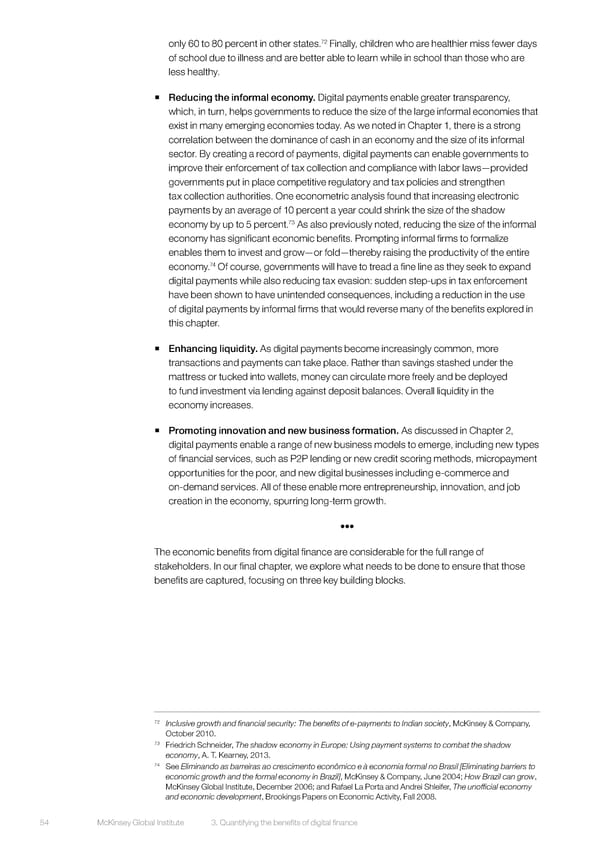72 only 60 to 80 percent in other states. Finally, children who are healthier miss fewer days of school due to illness and are better able to learn while in school than those who are less healthy. ƒ Reducing the informal economy. Digital payments enable greater transparency, which, in turn, helps governments to reduce the size of the large informal economies that exist in many emerging economies today. As we noted in Chapter 1, there is a strong correlation between the dominance of cash in an economy and the size of its informal sector. By creating a record of payments, digital payments can enable governments to improve their enforcement of tax collection and compliance with labor laws—provided governments put in place competitive regulatory and tax policies and strengthen tax collection authorities. One econometric analysis found that increasing electronic payments by an average of 10 percent a year could shrink the size of the shadow 73 As also previously noted, reducing the size of the informal economy by up to 5 percent. economy has significant economic benefits. Prompting informal firms to formalize enables them to invest and grow—or fold—thereby raising the productivity of the entire economy.74 Of course, governments will have to tread a fine line as they seek to expand digital payments while also reducing tax evasion: sudden step-ups in tax enforcement have been shown to have unintended consequences, including a reduction in the use of digital payments by informal firms that would reverse many of the benefits explored in this chapter. ƒ Enhancing liquidity. As digital payments become increasingly common, more transactions and payments can take place. Rather than savings stashed under the mattress or tucked into wallets, money can circulate more freely and be deployed to fund investment via lending against deposit balances. Overall liquidity in the economy increases. ƒ Promoting innovation and new business formation. As discussed in Chapter 2, digital payments enable a range of new business models to emerge, including new types of financial services, such as P2P lending or new credit scoring methods, micropayment opportunities for the poor, and new digital businesses including e-commerce and on-demand services. All of these enable more entrepreneurship, innovation, and job creation in the economy, spurring long-term growth. ••• The economic benefits from digital finance are considerable for the full range of stakeholders. In our final chapter, we explore what needs to be done to ensure that those benefits are captured, focusing on three key building blocks. 72 Inclusive growth and financial security: The benefits of e-payments to Indian society, McKinsey & Company, October 2010. 73 Friedrich Schneider, The shadow economy in Europe: Using payment systems to combat the shadow economy, A. T. Kearney, 2013. 74 See Eliminando as barreiras ao crescimento econômico e à economia formal no Brasil [Eliminating barriers to economic growth and the formal economy in Brazil], McKinsey & Company, June 2004; How Brazil can grow, McKinsey Global Institute, December 2006; and Rafael La Porta and Andrei Shleifer, The unofficial economy and economic development, Brookings Papers on Economic Activity, Fall 2008. 54 McKinsey Global Institute 3. Quantifying the benefits of digital finance
 DIGITAL FINANCE FOR ALL Page 67 Page 69
DIGITAL FINANCE FOR ALL Page 67 Page 69